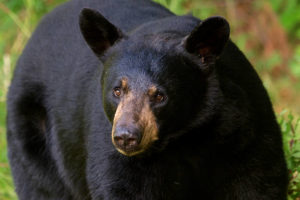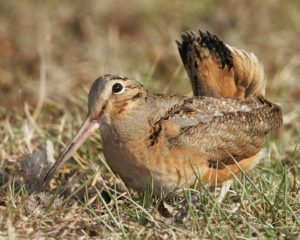The September Back Bear hunting season, which began on September 4 ended on September 22. Preliminary results show that approximately 150 bears were harvested. Most of the bears were checked in on-line and there may still be some checking stations yet to report. Last year’s September total was 151.
There were some large bears taken during this season. For example, there was one checked in on-line estimated to weigh 450lbs, (non-dressed) taken in New Marlborough, one weighing 435lbs (dressed) that was checked into the Buckland check station, one which weighed in at 342lbs (dressed) taken in Lee and another one weighing 375lbs (dressed) taken in Otis.
The November bear hunting season opens on November 5 and runs through November 24. There are different regulations, such as the type of hunting implement, applicable to this hunt so be sure to check the Massachusetts Guide to Hunting Laws (abstracts).
Teddy Bears picnic
The Lenox Historical Society (LHS) will be having a Teddy Bears Picnic on Saturday October 6 from 11:00 am to 1:00 pm at the Museum of Lenox History (Academy Building) 65 Main Street, Lenox. Dale Abrams, Education & Volunteer Coordinator for Mass Audubon’s Berkshire Sanctuaries will be the guest speaker. His talk will be geared toward children and will address living with the bears in our midst – where and what their dens are like, how they will spend the winter, what is appropriate behavior if they see a bear, etc. The LHS wants kids (and adults) to learn about their environment, especially since there are so many encounters with bears in the Berkshires.
The LHS will have an exhibit of teddy bears in its museum.
The presentation will last about an hour in order to have enough time for kids to ask questions. Light refreshments will be served after the talk. The event is free and open to the public.
Woodcock hunting season opens this week
The season opens on Thursday, October 4 and runs through Saturday, November 24, excluding Sundays. The daily bag limit is 3 and the possession limit is 9. Woodcock (Timberdoodle) hunters are required to complete a Harvest Information Program (HIP) survey, but no State or Federal waterfowl stamps are required.
Non-toxic shot is not required for woodcock, snipe or rails; however, if you are planning to hunt other species at the same time, no lead shot may be in the hunter’s possession while hunting ducks, geese or coot.
DFW talk on Chronic Wasting Disease
On Thursday, October 4, the Berkshire County League of Sportsmen (BCLS) will be hosting a presentation by David Stainbrook, MassWildlife’s Deer and Moose Project Leader at the Cheshire Rod & Gun Club, 310 Curran Rd, Cheshire, MA. Beginning at 7:00 pm, he will be giving a presentation on the Chronic Wasting Disease (CWD) which is a contagious neurological disease that is fatal to cervids, including deer, elk, and moose. The BCLS encourages you to attend this informative presentation which is free and open to the public.
Prior to Stainbrook’s presentation, beginning at 6:00 pm, the BCLS will conduct a short monthly meeting. The League is made up of delegates from the various Berkshire County sportsmen’s clubs, and the meetings include monthly reports by DFW Western District Supervisor Andrew Madden and MA Fish & Wildlife Board Member Stephen Sears. League and club delegate members discuss various subjects of interest to sportsmen. If you are a local outdoor sportsman who has never attended a BCLS meeting, you might want to come to that meeting and see what it’s all about. Who knows, you might want to represent your club at future meetings.
Dalton’s John Ballard takes 1st in trap shooting
Representing the Lee Sportsmen’s Club, John took 1st Place in a Registered Trap Shoot on September 1 and 2 in North Leominster, MA. He shot 195 out of 200 tries while competing against 150 others in the “C Class” category. No, he didn’t come home with a blue ribbon or trophy, but received a check in the mail.
John says that the Lee Sportsmen’s Club is always looking for new trap shooters. He and others teach trap shooting at the club on Saturday mornings. One caveat, don’t bother him on Saturdays during the goose hunting season.
According to Wikipedia, trapshooting is one of the three major disciplines of competitive clay pigeon shooting (shooting shotguns at clay targets). The other disciplines are skeet shooting and sporting clays. They are distinguished roughly as follows:
• In trap shooting, the targets are launched from a single “house” or machine, generally away from the shooter.
• In skeet shooting, targets are launched from two “houses” in somewhat “sideways” paths that intersect in front of the shooter.
• Sporting clays includes a more complex course, with many launch points.
There are variations within each group.
Trapshooting is practiced all over the world with certain variants. Olympic trap, also known as “International Trap”, “Bunker”, “ISSF Trap” and “Trench”; Double Trap is also an Olympic event. Other non-Olympic Trap include: Down-The-Line, also known as “DTL” and Nordic Trap. American Trap is the predominant version in the United States and Canada.
American Trap has two independent governing bodies. The Amateur Trapshooting Association (ATA) sanctions events throughout the United States and Canada, as well as the Pacific International Trapshooting Association (PITA) which sanctions events on the West Coast of North America.
Trapshooting was originally developed, in part, to augment bird hunting and to provide a method of practice for bird hunters. Use of targets was introduced as a replacement for live pigeons. Indeed, one of the names for the targets used in shooting games is clay pigeons. The layout of a modern trapshooting field differs from that of a skeet field and/or a sporting clays course.
Trapshooting has been a sport since the late 18th century when real birds were used; usually the passenger pigeon, which was extremely abundant at the time. Birds were placed under hats or in traps which were then released. Artificial birds were introduced around the time of the American Civil War. Glass balls (Bogardus) and subsequently “clay” targets were introduced in the later 1800s, gaining wide acceptance.
Field Trial
The Berkshire Beagle Club will be having a Small Pack Option Field Trial at its Richmond Club next weekend, October 6 and 7. The female beagles will run on Saturday and the males on Sunday. They will be having another TT15 Mini Collar raffle for $10 a ticket. 
Beaglers come from all over the Northeast to participate in these trials and have wonderful remarks about the condition of the grounds, the numbers of the bunnies available and how the field trials are conducted and judged. The grounds cover some 80 plus acres with both cottontail and snowshoe hares inhabiting them.
In the Beagle Club’s August field trial week-end they had 173 entries over the three days but there were no local winners. Maybe this time one of own local dogs will win. In all fairness, they are competing against some of the best beagles in the Northeast.
